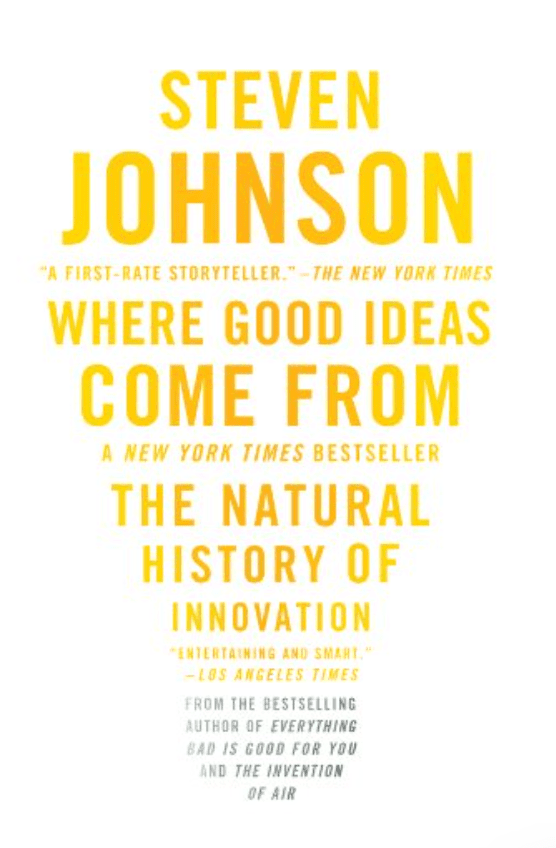
Introduction
In his enlightening book,Where Good Ideas Come From: The Natural History of Innovation (2010), Steven Johnson explores the complex ecosystem of innovation and creativity. As an acclaimed author and media theorist, Johnson delves into how good ideas emerge, flourish, and often take unexpected forms. Understanding these processes is crucial in today’s rapidly evolving landscape of ideas, where creativity is a driving force behind technological advancements and cultural shifts.
1: The Concept of Innovation
1.1 Defining Innovation
Johnson defines innovation as the transformation of ideas into something impactful and useful. Unlike mere ideas, innovations are refined, actionable concepts that can change industries and societies. According to the Harvard Business Review, innovation can take various forms, from incremental improvements to groundbreaking inventions.
1.2 The Nature of Good Ideas
Good ideas possess distinct characteristics: they often arise from a combination of creativity, collaboration, and the right environmental conditions. As Johnson argues, fostering a culture of openness and sharing can significantly enhance the likelihood of generating these valuable concepts.
2: Key Themes in “Where Good Ideas Come From”
2.1 The Slow Hunch
One of the book’s central ideas is that of the slow hunch—the notion that significant insights often develop gradually over time. Johnson provides several historical examples, including the work of Charles Darwin, to illustrate how initial hunches can evolve into groundbreaking theories.
2.2 The Adjacent Possible
The adjacent possible concept emphasizes that every innovation is built on the framework of existing ideas and technologies. This interconnectedness suggests that to innovate, one must explore the boundaries of current knowledge. The adjacent possible represents the space of what could be created next. For a detailed exploration, refer to The New Yorker.
2.3 Liquid Networks
Johnson highlights the importance of liquid networks—fluid connections among individuals in collaborative environments. These networks facilitate the exchange of ideas and foster creativity. Examples, such as the interactions among scientists in the early days of Silicon Valley, showcase how collaboration fuels innovation.
2.4 Serendipity
The role of serendipity is another vital theme, suggesting that chance encounters can lead to significant breakthroughs. Johnson cites numerous examples, including the discovery of penicillin by Alexander Fleming, to emphasize that being open to unexpected experiences can catalyze innovation.
2.5 The Importance of Shared Spaces
Physical and digital shared spaces play a pivotal role in nurturing creativity. Environments that are conducive to collaboration—such as co-working spaces or innovation hubs—can significantly impact the idea generation process. For insights into creating effective collaborative workspaces, see Forbes.
3: The Historical Context of Ideas
3.1 Historical Figures and Their Innovations
Johnson discusses several historical figures whose environments shaped their innovative thinking. Figures like Thomas Edison and Nikola Tesla had unique contexts that influenced their groundbreaking contributions to technology.
3.2 Evolution of Ideas Over Time
The evolution of ideas is closely tied to technological advancements and historical events. Johnson traces how innovations like the printing press or the internet have reshaped communication and idea-sharing across generations.
4: Practical Applications of the Book’s Ideas
4.1 Fostering Creative Environments
Individuals and organizations looking to cultivate innovation can implement several strategies inspired by Johnson’s insights. Techniques such as brainstorming sessions, creative workshops, and innovation labs can enhance the creativity of teams. Refer to McKinsey & Company for a deeper understanding of fostering innovative cultures.
4.2 Encouraging Collaboration
Collaboration is integral to generating new ideas. Organizations can build collaborative networks by implementing cross-departmental projects and leveraging technology to facilitate communication.
5: Critiques and Considerations
5.1 Potential Limitations of Johnson’s Ideas
While Johnson’s book offers valuable insights, some critiques suggest that it may oversimplify the innovation process. Critics argue that not all ideas can be traced through a clear path of development or collaboration. Engaging with criticisms found in journals like Innovation: Organization & Management can provide a balanced perspective.
5.2 Personal Reflections
Upon reflecting on Johnson’s work, it becomes clear that the book resonates profoundly with anyone interested in the dynamics of creativity. The exploration of how diverse influences shape innovations can inspire readers to examine their creative processes.
Conclusion
In conclusion, “Where Good Ideas Come From” presents a compelling exploration of the nature of innovation and the myriad factors that influence idea development. Johnson’s insights are not just theoretical; they are practical and applicable in various contexts, making this book a valuable read for anyone interested in enhancing their creative potential.
Call to Action
I encourage readers to share their thoughts on Johnson’s insights and how they might apply them in their fields. For those interested in delving deeper into the discussions of innovation, consider exploring additional resources like The Innovator’s Dilemma by Clayton Christensen or “Creative Confidence” by Tom Kelley.
References
-
- Johnson, S. (2010). Where Good Ideas Come From: The Natural History of Innovation.
- Harvard Business Review. (2006). The Four Ways That Innovation Can Happen.
- The New Yorker. (2010). Where Good Ideas Come From.
- Forbes. (2019). The Evolution of the Modern Workplace.
- McKinsey & Company. Creating a Culture of Innovation.
- Innovation: Organization & Management.
- History.com: Thomas Edison and Nikola Tesla.







